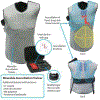Development and Evaluation of a Wearable Simulator System
- PMID: 38053582
- PMCID: PMC10695350
- DOI: 10.1016/j.ecns.2023.101428
Development and Evaluation of a Wearable Simulator System
Abstract
Background: Peer physical examination is a clinical teaching-learning approach used for decades because of the convenient sample of peers for practicing. However, this approach has limitations when learning to assess abnormalities and threatens psychologically safe learning. A wearable simulator system was designed for learning physical examination skills to minimize ethical and learning challenges.
Sample: The sample consisted of fifty prelicensure nursing students and ten faculty in an upper Midwest university.
Method: The wearable simulator was constructed into a vest with RFID tags and ribcage landmarks. An observational, evaluative design was used for participants to rate seven categories during a one-hour evaluation session of the wearable simulator worn by a standardized patient trained to portray an individual with pneumonia.
Results: Satisfaction was rated highly among participants. More than 80% of student participants indicated the wearable simulator promotes privacy and reduces embarrassment.
Conclusion: The wearable simulator system offers a promising teaching-learning alternative with scenario-specific auscultation and palpation feedback to provide a safe, repeatable, and consistent simulation experience.
Keywords: health assessment; physical exam; privacy; psychological safety; simulation; wearable.
Figures
References
-
- Brown WJ, & Reid C. (2022). Implementing a cost effective and configurable hybrid simulation platform in healthcare education, using wearable and web-based technologies. Smart Learning Environments, 9(1). 10.1186/s40561-022-00201-1 - DOI
-
- Demiray A, Kiziltepe SK, İlaslan N, & Acil A. (2020). The effect of high-fidelity simulation in improving the physical examination skills of nursing students. International Journal of Nursing, 7(1), 8–17. 10.15640/ijn.v7n1a2 - DOI
-
- Doğdu AK, Arikan F, & Kol E. (2021). Physical examination skills used by nursing students and determination the barriers encountered in the use of these skills. Journal of Education and Research in Nursing, 18(3), 335–340. 10.5152/jern.2021.67944 - DOI
Grants and funding
LinkOut - more resources
Full Text Sources


